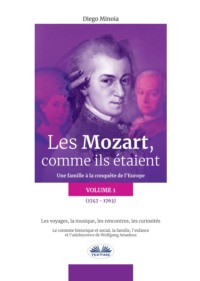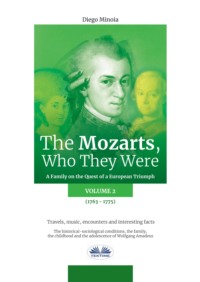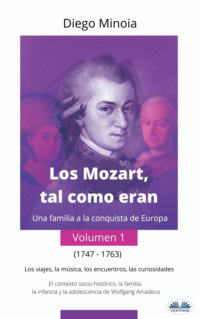
Полная версия
The Mozarts, Who They Were Volume 2
Men wore daggers adorned with ribbons which were highly fashionable in Paris, made of very thin fur, causing Leopold to mockingly comment that something so ridiculous would surely impede the dagger from freezing.
Even excessive love for luxury by the French was reproached by Leopold, in particular the habit of sending newborns to caretakers in the countryside, entrusting them to a “tenant” who would distribute the children to the wives of farmers, where they wrote the names of the parents and guardians in a ledger in collaboration with the local parish in exchange of an offering for their “certification”.
The “care” of children in the 18th century in Paris – To be born female was a difficult fate
In general, when a female child was born, it was a disappointment for the parents. Wealthy or poor, the reaction was the same.
No celebrations and above all, a fate marked by a “lesser” future in comparison to male children. It would not be her who carried the family lineage, or to inherit property and public positions (in the case of noble families) and it would not be her to contribute to the sustainance of the family with physical strength, unless helping in the household or working as a housekeeper (in the case of poor families).
In the aristocratic homes, newborns were immediately entrusted to the tenants and taken away from their homes and mothers until they were weaned.
The tenants were often ignorant farmers that neglected the children often to the point of death or, as happened to Charles-Maurice de Talleyrand-Périgord (Prince and later an astute politician for all seasons), was rendered an invalid.
It appears, in fact, that Talleyrand had a permanent limp due to a fall from a chair that was too high of which the absent-minded tenant had left him unattended.
After the children were weaned, they were returned to their families and were entrusted to a nanny who looked after their every need, from basic education (reading and writing, catechism, some bible study) to attending to their personal habits, often with the aid of the many publications dedicated to educating children.
There was no familiarity with the mother, let alone with the father, if not on the occasion of the morning visit to the mother's room where she received him or her with indifference, paying more attention to her dogs.
From a very young age, the wealthy daughters were dressed like the adult women (corset, farthingdale, noteworthy hairstyles complete with a hat, etc.) and were given dolls with complete wardrobes.
The weekly magazine of information Le Mercure de France announced to its readers in 1722 that the Duchess d'Orleans had given the Dauphine of France (wife of the Dauphin who was first born son and heir to the King of France) a doll with a complete wardrobe and jewels of astronomical value for those times: £22,000.
When the wealthy girl reached the age of six or seven years old, she began to receive dance, singing and music (harpsichord) lessons in order to prepare her for her role in society...and in the end would be sent to a convent, based on the prestige of the other girls she consorted with.
It was obviously not a monastic life as we are accustomed to imagine it today but a kind of boarding school where the girls lived a relatively secluded and morally "guaranteed" life: there were well-furnished apartments for girls of noble lineage and in the most prestigious convents, contacts and friendships were intertwined between the girls who, once they were released and returned to the world through marriage, would be able to obtain social and economic advantages for the family of origin and that of the husband.
It often happened that the young women were married by exclusive decision of the family without consulting the daughter from the age of twelve or thirteen and then sent back to the convent until they reached the appropriate age to consummate the marriage.
Thus it was for a daughter of Madame de Genlis, married at the age of twelve, and for the Marquise de Mirabeau of which she became the widow of the Marquis de Sauveboeuf at thirteen.
In particular convents there was also a curious typology of girls who, even without pronouncing binding religious vows, received a habit and the honorary title of Canoness, which gave prestige to them and to the families to which they belong: however they had the obligation to reside in the convent two out of three years.
The Canonesses were divided, according to age, into Dame aunts, each of whom was entrusted with a Lady niece, who would receive her support to build relationships with the other Ladies and, on the death of her aunt, would inherit her furniture, the jewels and any income and benefits related to her office in the convent.
The main convents and most coveted by the noble families were that of Fontevrault, in the Loire Region (where the Daughters of France, the daughters of the Kings and Dauphins of France were educated), that of Penthémont (where the Princesses were educated and "they withdrew" the Dame of quality once they became elderly or widows).
Hospitality in these convents was not free, on the contrary. In 1757 the cost could range, in Paris, from 400 to 600 livres to which other expenses were added: 300 livre for the maid plus more money for the trunk, bed and furniture, for heating wood and for candles or oil for lighting, for washing linen, etc.
At the convent of Penthémont, the most expensive, there was the distinction between ordinary pension (600 livre) and extraordinary (800 livre which became 1,000 if the boarders desired the honor of eating at the Mother Superior's table).
At the end of their preparation in the most prestigious convents the girls were ready for marriage and, if we give credit to what their contemporaries thought, "they knew everything without having learned anything".
Marriage, for most of these girls, simply represented the fulfillment of the family project and had value for the status she would give them, based on her husband's condition, and for the luxury and comfort she would allow.
As new brides, they would then begin the tour of visits to the aristocratic circle of friendly families of their family and their husband to affirm her new condition as married women ready for society life, with a side of fashionable clothes, jewelry, hairstyles. to show off at the Opera and on every occasion, especially if you belonged to the elite who had the opportunity to access the "presentation" at the Court.
At that point, to be capable, the girl had to learn the fashionable words and use them naturally: Amazing, Divine, Miraculous, are terms to be used to describe a musical performance at the Opera rather than a new hairstyle or a new dance step.
A lady's day did not begin until eleven o'clock, when she woke up, she called the maid who helped her wash and dress while the mistress stroked the inevitable pet dog that slept in her room.
The fact that the habit of nursing newborn children to ignorant peasants who often neglected them was widespread not only among the aristocrats but also in decidedly less wealthy sections of the population (the cost, in fact, was very low) which caused disabilities that, for the poor meant misery and marginalization for the rest of their lives. Leopold observes that in Paris one could not easily find a place that was not full of miserable and crippled people.
In and out of churches or walking in the streets one was continually subjected to requests for money from the blind, paralyzed, crippled, pustular beggars, people whose pigs had devoured a hand as children, or who had fallen into the fire and burned their arms while their keepers had left them alone to go to work in the fields. All this disgusted Leopold, who avoided looking at those poor people.
The poor
Social inequalities were extremely large in the 18th century.
In the face of an aristocratic class, which lived in luxury and which was "forbidden" to work (thus living off the remaining part of the population) and among the large and middle bourgeoisie (which got along quite well thanks to finance, trade and professions), there were crowds of poor people and going farther down the social ladder, of miserable people without a home, food or family.
Of Neapolitan beggars, Prince Strongoli says in 1783, that "they overflowed without a family" because misery often prevented the formation of family ties or even caused their disintegration, with husbands abandoning their families or children leaving to seek better fate elsewhere, usually in some city where they hoped for more opportunities.
The needy not only included slackers and wanderers by choice but also all those who were unable to earn their daily bread because they were too old or too young (although children started working at a very young age), disabled or sick.
During Prince Strongoli's time, it is estimated that in Naples a quarter of the population (100,000 out of 400,000 inhabitants) belonged to the poor or miserable class.
The number of the poor then increased or decreased also on the basis of contingencies: famines, wars, job losses, diseases, epidemics could increase the percentages even to 50% or more in moments of the worst crisis.
Without reaching the frightening numbers of Naples at the end of the 1700s, poverty was also great in other European cities: from south to north (Rome, Florence, Venice, Lyon, Toledo, Norwich, Salisbury) ranging between 4% and 8% of the population.
One can therefore easily imagine the enormous mass of miserable and poor people in Europe, considering that the continent's population amounted to about 140 million in the mid-1700s rising to 180 million on the threshold of the French Revolution.
A small part of the enormous mass of poor children, because they were orphans or belonging to families who were unable to feed and care for them, were "taken care of" by the Conservatories or Hospitals which, born in Naples, Venice and other Italian cities during the 16th century, also spread to other large European cities.
In his letters, Leopold also refers in passing to the remains of the famous "Querelle des bouffons", the dispute between the supporters of the Italian theatrical musical style (performance of the Serva padrona – “The Maid Turned Mistress”by Pergolesi) among which the encyclopedists with Jean-Jacques Rousseau in the front row, and the admirers of the French style à la Lully (who, incidentally, Giovan Battista Lulli, was also Italian, in spite of the French name). Although the discussion had been resolved a dozen years earlier, evidently the controversial aftermath had not completely subsided and Leopold does not hold back from giving his opinion on the matter: French music, all of it, is worth nothing while the German musicians present in Paris or whose printed compositions were widespread in the French capital (Schobert, Eckard, Honauer, etc.) were helping to change the musical taste of their French colleagues. Some of the main composers operating in Paris, Leopold writes, had brought their published compositions to Mozarts while Wolfgang himself had just delivered 4 Sonatas for harpsichord with violin accompaniment marked in the Mozart catalog as K6 and K7 (those dedicated to the Delfina Victoire Marie Louise Thérèse, daughter of King Louis XV) and K8 and K9 (those dedicated to the Countess of Tessè). We will speak more about the compositions published in Paris by Wolfgang (but composed in the previous months, not without the help of his father) after completing the information on the stay of the Mozarts in the French capital. In the meantime, Leopold figures out, and does not fail to highlight it to his interlocutors from Salzburg, the clamor he expects will provoke the Sonatas by his son, especially considering the age of the author.
Nor is he afraid that Wolfgang could be put in crisis by any public proofs of his abilities, proofs that had already been faced and overcome not only at the level of executive virtuosity (execution, sight reading, transposition into other tones, improvisation, etc. .) but also, according to what he says, at the level of composition when he was put to the test in writing a bass and the violin accompaniment of a minuet. Little Wolfgang's progress was so rapid that his father imagined that, upon returning to Salzburg, he could take up court service as a musician.
Nannerl also performs with precision the most difficult pieces that are submitted to her, but for her Leopold does not make grandiose projects: she is a woman and the prejudices of the time, fully shared by Leopold Mozart, make her at best a performer with prospects of living by giving lessons to the offspring of wealthy Salzburg families.
In the letter of February 22, Leopold Mozart announces the death of Countess van Eyck to Hagenauer, who had been hosting the whole family in her palace for months (no one bothered to prick the soles of her feet to make sure she was really dead, Leopold notes) and the disease that had affected Wolfgang: a sore throat with a cold so strong that it caused inflammation, high fever and the production of pleghm that he was not completely able expel.
The death of the Countess forced the Mozarts to look for a new place to live and Grimm found them an apartment in Rue de Luxembourg. On the occasion of little Wolfgang's illness we discover one of Leopold Mozart's characteristics, namely his competence (empirical but also based on reading and experience) in the medical field. In the correspondence, in this case as on other occasions, we find the treatments that he himself administered to family members on the basis of personal diagnoses or, for the most serious cases, on the indications of the doctors consulted.
First he made Wolfgang get out of bed and walked him back and forth around the room while, to bring down the fever, he repeatedly administered small doses of Pulvis antispasmodicus Hallensis (Halle's antispasmodic powder). This medicine, which took its name from the German city of Halle (in Saxony, near Leipzig), was based on Assa fetida (a resin of Persian origin), Castoreum of Russia (glandular secretion produced by the beaver in the period of the "scrub", sold at a high price so that it was often falsified or replaced by the less precious one imported from Canada), valerian (a plant rich in flavonoids still used today to promote sleep and reduce anxious phenomena), purple digitalis (plant containing active ingredients with effects on decompensation heart), sweet mercury (85% mercury oxide and 15% muriatic acid) and sugar. That concoction, whether it was effective or not, certainly did not kill the boy and probably helped Wolfgang to recover within four days.
For safety, however, Leopold, who cared obsessively about his son's health (an illness would have put projects and earnings at risk and the four days of forced rest, he calculated that they could have earned an extra 12 Louis of gold), also consulted a German friend, a certain Herrenschwand, doctor of the Swiss Guards who protected the King at Versailles.
Because the medicus only showed up twice to visit Wolfgang (Leopold writes it as if his doctor friend had neglected his duties, but evidently the disease was not so serious as to require daily visits) he thought it best to integrate the treatments with a some Aqua laxativa Viennensis (Viennese laxative water), a popular medicine certainly less dangerous as it is composed of Senna (Plant of Indian origin with laxative effects), Manna (extracted from the sap of the ash, with emollient and expectorant properties, slightly laxative), Creme of tartar (tartaric acid with natural leavening properties) mixed in six parts water.
Medicine in the 18th century
Mortality in the second half of the 18th century in European cities was four times higher than today. Vienna, with a population of around 270,000, had a death rate of 43 per thousand. The main reason was the large number of diseases present at the time, such as smallpox, typhus, scarlet fever and, in children, diarrhea. In addition, chronic infections such as tuberculosis and syphilis increased the death toll.
Life expectancy in the second half of the 18th century, especially in cities, was 32 years. The main reason was the high infant mortality rate. In the years 1762 to 1776, the average mortality rate of children under the age of two was 49% and at least 62% of children died within the fifth year. The main cause was diarrhea due to poor hygiene and inadequate infantile nutrition. Breastfeeding by mothers was not popular, so middle and upper-class women resorted to nurses for their children, who belonged to the lower classes and, often, were themselves carriers of disease.
Another method used was baby food, consisting of bread boiled in water or beer with the addition of sugar.
Wolfgang Mozart possessed erroneous notions about it, as evidenced by a letter written to his father in June 1783 on the occasion of the birth of his first child, Raimund Leopold, in which it is highlighted that he was against breastfeeding. He would have liked the baby to be fed only baby food, as it was for him and his sister.
Fortunately he gave in to the insistence of his mother-in-law and the son was entrusted to the care of a nurse even if, unfortunately, it was ineffective, and the baby lived only four weeks.
The therapies used at the time were poorly effective.
Gradually the notions deriving from medieval medicine were discarded, but in their place there were few alternatives.
For example, quinine in the form of Peruvian bark was used against malaria; opium was the only known analgesic, while mercury was used against syphilis.
Furthermore, the theory of mood disorder of the disease was still in vogue, which provided the removal of body fluids in order to expel bad moods and thus restore balance.
Therefore emetics, laxatives, enemas and bloodletting were widely used.
During the 18th century, medical techniques were used that today make us laugh, such as "tobacco smoke enemas", which were practiced in particular to reanimate drowned people (in London, but also in Venice, along the river or canals, in the apothecaries rather than in the parishes, at the piers and harbors, boxes with the equipment necessary to practice this therapy, just as is the case today for the defibrillators used in the case of cardiac arrest).
Leopold Mozart was probably always interested in medical treatments, the newest remedies and, more generally, scientific news, becoming aware of them during his long stay in London during the European Grand Tour.
Given the scarcity of official medicine results, "do-it-yourself" remedies were widely used, and as we have seen, the Mozart family was by no means exempt.
Here is a table of the most used medicines at the time:
- margravia powder (magnesium carbonate, mistletoe, etc.). Originally produced by the Berlin chemist Andreas Margraff (1709-1782);
- black powder, also called Pulvis Epilepticus Niger (seeds of croton, scammonea, peony, animal products, etc.). By far the most used remedy as it contained strong laxatives. It was used against epilepsy and also contained dried ground worms;
- scabiosa tea;
- rhubarb root;
- elderberry tea;
- white ointment (lard, white lead);
- anti gout pills (cooked seaweed or sponge)
Despite the approximation of many diagnoses and related treatments, we must not underestimate the evolution that the rationalistic thought of the 1700s allowed for the development of medical science which, thanks to the experimental method, made great strides forward and paved the way for subsequent progress.
Precisely in the 18th century, especially from the second half, the practice of medicine began to take on the modern characteristics as we know them today.
Characters such as Giovanni Battista Morgagni (1682-1771) founder of pathological anatomy, Antoine Laurent Lavoisier (1743-1794) founder of modern chemistry, Lazzaro Spallanzani (1729-1799) scientist with many interests who was defined by Pasteur as "the greatest scientist who ever lived", Georges Buffon (1707-1788) the greatest naturalist of his time, Edward Jenner (1749-1823) discoverer of the smallpox vaccine, etc.
The development of medical science is accompanied by the transformation of hospitals from places of segregation of the sick, infamous prisons with very high mortality rates, to health care institutions where, albeit with extreme slowness, increasingly more hygiene and care systems were effectively making their way.
Bedside medicine (in which for centuries the medicus went to the patient's home to administer more or less effective treatments) was gradually replaced by hospital medicine along with consequent changes in the doctor-patient relationship.
The Austrian Emperor Joseph II in 1784, the year in which Wolfgang Mozart lived in Vienna reaping success and glory everywhere, promoted the foundation of the Allgemeines Krankenhaus (General Hospital).
However, the evolution of medical science did not prevent people, such as Leopold Mozart, from continuing to make use of traditional and commonly used self-care practices for a long time, the so-called "doctorless medicine" (diet, bloodletting, purge, ointments more or less dangerous to health, recipes taken from printed booklets, etc.) and characters not always prepared, such as apothecaries, surgeons and barbers continued to perform functions related to health, not to mention the charlatans who peddled concoctions of all kinds as miraculous solutions to all evil.
How can we not cite here a symbol of the charlatans of every era Doctor Dulcamara who, in Donizetti's "Elisir d'amore" staged in 1832, sold flasks of Bordeaux wine as a general remedy in the air "Hear, hear, rustic folk": Benefactor of men, repairer of evils, in a few days I will clear out, I will sweep the hospitals, and I want to sell health for the whole world. Buy it, buy it, I'll give it to you for cheap. This is the marvelous odontalgic liqueur, of mice and mighty destroying bugs, whose authentic certificates, stamped to be seen and read by each one I will do. For this specific, likeable mirifico of mine, a septuagenarian and valetudinary man, grandfather of ten children I am still to become.
For this reason Touch and Heal in a short week more than one afflicted young man ceased to cry. Or you, stiff matrons, do you yearn to rejuvenate? Your wrinkles uncomfortable with it erased. Do you, damsels, want to have smooth skin? You, gallant young people, forever have lovers? Buy my specific cure, I'll give it to you for a little while. It moves the paralytics, dispatches the apopletics, the asthmatics, the asphyxiates, the hysterics, the diabetics, heals tympanitides, scrofula and rickets, and even the liver pain, which in fashion became. Buy my specific cure, I'll sell it cheap.
The fears for the health of Wolfgang (above all) and Nannerl prompted the parents to vow to have masses recited in Salzburg in case of recovery: 4 masses at the Shrine of Maria Plan (not far from Salzburg) and 1 mass at the altar of the Child Jesus in the Loretokirche that was in the city. The costs of the masses were then to be deducted from the Mozarts' account with Hagenauer. Among the novelties that Leopold tells the Salzburg correspondents there was also the practice of inoculating smallpox which, he says, he was repeatedly invited to do to his children. Inoculation or variolation was introduced in Europe in 1722 by Lady Mary Wortley Montagu, wife of the English ambassador to Constantinople, who had seen it practiced in Turkey. She had her first child inoculated and the second was even publicly inoculated at the English Court, as a demonstration of the efficiency of the method.
The positive result caused the entire English Royal Family to undergo inoculation. In Paris it seems that at the time when the Mozarts were present in the city it was a rather widespread fashion, so much so that laws were promulgated which, except for special permits, prescribed their practice in the city (to avoid contagions) while in the countryside it was allowed. Inoculation was a form of defense against smallpox, at the time the most widespread infectious disease in Europe, and consisted in exposing the subject to a mild form of the disease which allowed, in case of positive success, to immunize him from the most common forms, serious and often fatal. The practice, however, had serious risks both for the person subjected to inoculation (he could get sick with the most severe form) and for those who spent time with him during the active phase of the disease.







